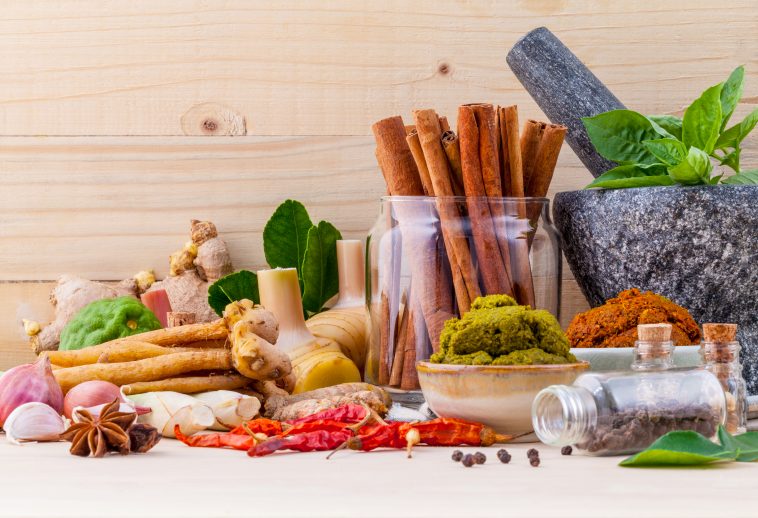Herbs and spices are important commodities for different reasons. Not only do they serve as an important source of income for farmers, but they are important substances for use in foods and medicines.
Therefore, farming with herbs or spices can be an excellent investment for African growers. Herbs are generally identified as the leaves of non-woody plants that are used as an aromatic supplement. Spices, on the other hand, comes from the roots, fruits, seeds, rhizomes, stems, leaves, bark, and flowers. Herbs are usually fresh or dried, chopped, or whole. Spices are usually dried and take many forms such as crushed or ground to a powder. With the growing population, the demand for aromatics will continue to grow alongside food production such as fruits and vegetables.
Starting a spice or herb farm has the following benefits:
- There is a high demand for spices which makes it easy to market.
- The operation is simple to start.
- Value can easily be added to increase revenue.
- Intercropping between other crops such as bananas can double production on a limited space.
- Spice and herb farms are easy to operate, even from a distance while living elsewhere.
It is important to note that there are also risks involved in starting a herb and spice farm. As with any crop, an entire harvest can easily be lost due to weather conditions or acts of nature such as drought. Input costs can be high, especially if fake products or the right products in the wrong quantity are used. The biggest risk involves the lack of qualified or skilled management and employees. The lowest risk is the price fluctuations between peak season and off-season production.

Growing herbs and spices in Africa is a hidden opportunity
Due to the multiple uses these plants can have, herbs and spices have been a successful economic investment for many growers. Spice has proven itself as a lucrative business. Saffron, for instance, remains more expensive than gold. Despite the opportunity that farming with these botanicals have, Africa still produces less than 10% of spices worldwide.
The countries that are mainly responsible for production include Nigeria, Madagascar, Morocco, Tanzania, Uganda, Kenya, Cameroon, and Ghana. Nigeria and Cameroon fall into the top ten global producers of ginger, and Kenya and Tanzania remain in the top six positions for clove production. During the 2020 production year, 5 955 838 tonnes of spices were produced, but it is only a fraction of the potential yield that can be achieved. But to put this number in context, the spice crops counted in this calculation is set out in the table below.
Africa is suitable for herb and spice production
Africa’s wide array of climates makes the continent ideal for spice and herb production. Certain areas are more suitable for certain types of spices than others. There are three categories of spice, namely tropical spices, subtropical spices, and temperate spices.

Tropical spices
Tropical spices need high temperatures and ample humidity. Low temperatures can easily destroy these plants. Some examples include ginger, turmeric, black pepper, cinnamon, kokan galangal, cardamon, and cloves.
Subtropical spices
Subtropical spices ae characterised by three seasons: winter, summer, and monsoon season. These spices require the cold winters for their early growth stage and high summer temperatures for their reproductive stage. Examples include cumin, fennel, coriander, fenugreek, onion, and garlic.
Temperate spices
These spices tolerate low temperatures and frost, but high temperatures damage plants. These include thyme, saffron, savoy, caraway, and asafoetida. It is therefore important that every grower first research which spices will fare best in his climate, and the soil requirements for the specific spices.
Many herbs and spices can be grown in Africa
There are more than 500 herbs and spice varieties worldwide. Internationally speaking, there are 50 spices of global importance, but in Africa, there are other lesser-known aromatics that are popular in local cuisine. The hidden opportunity lies in the fact that, apart from the spices mentioned in the table, many others that originated from South America, the Caribbean, and Asia have been grown successfully in Africa. Research and knowledge of the climate will ensure that their cultivation will succeed. An added advantage is that farmers can grow the produce organically.

Here is a list of some of the spices that can be grown in Africa:
Ajwain, cardamon, chilli, cinnamon, cloves, coriander, cumin, ginger, hyssop, iru, kan kan kan, mace, nutmeg, oregano, paprika, pepper, poivre de penja (a type of pepper), saffron, sesame, sumac, thyme, turmeric, za’atar.
Sources:
10 most popular African herbs and spices (2023) WHAT TO EAT IN AFRICA? TasteAtlas. Available at https://www. tasteatlas.com/most-popular-herbsand-spices-in-africa
How to plan, start and profit from a Spice Farm in Africa (no date). Africa Business Plans. Available at https://africabizplans.com/free-business-ideas/how-to-start-a-spice-farm-in-africa
Iwuoha, J.-P.N. (2017) Spices – how African entrepreneurs can build a business from this old but lucrative product, Spices – How African Entrepreneurs Can Build A Business From This Old But Lucrative Product. Smallstarter Africa. Available at https://www.smallstarter.com/browse-ideas/how-to-start-aspice-business-in-africa/
Knoema (2020) The production of spices in Africa, World Data Atlas. Available at https://knoema.com/data/agricultureindicators-production+africa+spices
Spices and Condiments: Classification based on climate requirement of the crop (no date). Indian Agricultural Statistics Research Institute. Available at http://ecoursesonline.iasri.res.in/mod/page/view.php?id=105643









